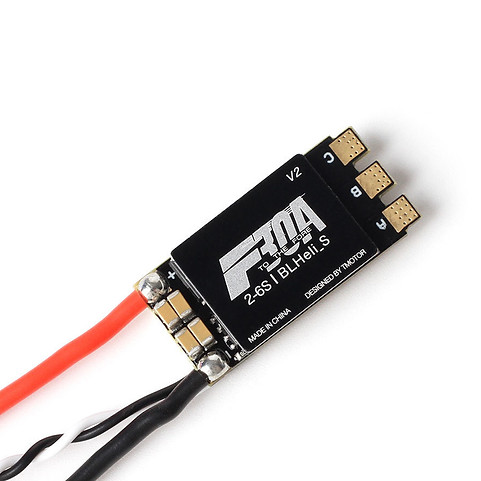What is ESC
ESC 代表
Electronic Speed Controller電子速度控制器 (電變 / 電調)
ESC control and adjust the speed of the brushless motors. The ESC receives signal from the flight controller causes the ESC to raise or lower the voltage to the motor as required, thus changing the speed of the propeller.

Parameters
How to choose ESC?

Single ESC
Individually connected to each motor of the drone, if one burn, just swapped out individually, lower cost and easy to repair.
4 in 1 ESC
Which is basically four ESC’s integrated into one single board, can stack together to make wiring much simpler and cleaner. Damaging one of the ESC’s means need to change the whole board.
4-in-1 ESC’s are also beneficial in terms of weight distribution, as the mass is more centralized.

What inside in ESC

Capacitors
for noise filtering.
Gate Drivers
power amplifier that accepts a low-power input from MCU and produces a high-current drive input for the gate of a high-power transistor such as MOSFET.
Plug Connector
Battery Pads
Motor Pads
Voltage Regulator
MCU
Micro-controller, small computer of ESC.
Current Sensor
MOSFET
MOSFET (or FET) that basically do all the hard work handling high current. The FET’s are bigger and beefier on higher current ESC’s, and they don’t genete as much heat as the smaller ones, therefore they can be more energy efficient.

Size
For 4in1 ESC, common 3 main sizes based on the mounting hole.
-
30.5 x 30.5mm
-
20 x 20mm
-
26.5×26.5mm (toochpick / whoop sizes)
The bigger 30.5 x 30.5 mm boards are usually more durable and more powerful, also better for heat dissipation.
Some 20 x 20mm boards are very powerful too, but the lack of physical space means they tend to use smaller FET, and there’s less room to put components on.

Voltage
Some ESC’s support input voltages up to 8S, some only support up to 4S. Make sure they are compatible with your LiPo voltage. Powering ESC with an excessively high voltage will fry ESC.
Current Ratings
which is measured in Amps (A), It’s the limit on how many amps you can put an ESC through without breaking it, not how much current it pushes to the motors.
There are 2 current ratings to an ESC:
Continuous current rating indicates the maximum amount of continuous current which the ESC can safely handle.
Burst current rating: withstand a higher current for short periods of time (e.g. a few seconds full throttle on racing).
Some things that tend to increase current draw on ESC:
-
Higher Motor KV
-
Larger Motor size (stator width and height)
-
Larger Propellers (length and pitch)
Protocols
Protocols are like the OS (Operating systems) in the world of ESC’s. They determine how fast the ESC and FC (flight controller) can communicate
Protocol Latency
Standard PWM 1000-2000 µs
Oneshot125 125-250 µs
Dshot150 106.7 µs
Oneshot42 84 µs
Dshot300 53.3 µs
Dshot600 26.7 µs
Multishot 15-25 µs
Dshot1200 13 µs
Dshot1200 are more accurate data at higher resolution, data error rejection, higher speed and lower latency.
Dshot600 is still the most popular choice and widely available. If asked can one feel a difference between an ESC with Dshot600 and Dshot1200 while flying, the answer is NO. Technically yes, Dshot1200 is better but if you want to run 32K/32K looptime if you have no other choice but to pick Dshot1200.
Firmware
ESC firmware is the software that is running on each ESC, there are different types of ESC firmware:
SimonK (no longer being updated,
BLHeli
BLHeli_S, 2nd generation of the BLHeli
BLHeli_32, 3nd generation of the BLHeli
KISS firmware
*BLheli firmware and Simonk firmware are open sources and KISS firmware is closed source meaning it can run with only KISS ESC.
Processors
The majority of multirotor ESC’s on the market use processors (micro-controller or MCU) from ATMEL, Silabs and ARM Cortex. The different MCU’s have different spec and features, and are supported by different firmware:
-
ATMEL 8-bit compatible with both SimonK and BLHeli ESC firmware
-
SILABS 8-bit supported by BLHeli or BLHeli_S only
-
ARM Cortex 32-bit (e.g. STM32 F0, F3, L4) – can run BLHeli_32
These 32 bit ESC’s have more processing power, faster input signals and much lower latencies can be achieved.
There is a downside for all these extra features, since it is closed source the ESC manufacturers have pay a license fee for the developers at BLHeli and what this means an increase in cost of the ESC’s themselves.

Wiring
ESC has 3 soldering pads which soldered onto the 3 wires from the motor.
Connecting any 3 wires will make the motor to spin. But the direction in which the motor rotates depends on the order in which the wires are connected. Matching the 3 wires from the top to bottom will make the motor to spin clockwise and swapping any 2 wires will make the motor to spin in anti-clockwise direction.
